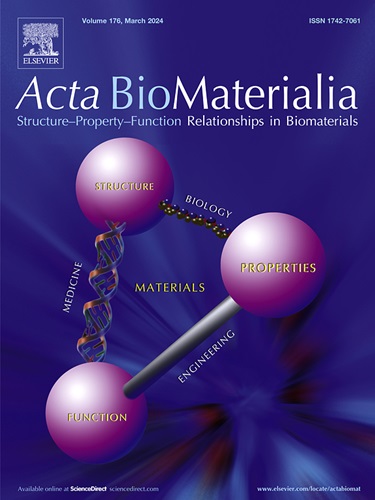三阴性乳腺癌相关成纤维细胞的侵袭性表型是机械敏感的,ahr依赖性的,并与疾病状态相关。
IF 9.4
1区 医学
Q1 ENGINEERING, BIOMEDICAL
引用次数: 0
摘要
癌症相关成纤维细胞(CAFs)在促进肿瘤细胞在转移过程中的侵袭中起着至关重要的作用。它们还通过纤维化灶的形成来调节肿瘤微环境的局部生物物理特征,这与乳腺癌的侵袭性有关。然而,不断发展的三维生物物理肿瘤微环境对CAF功能的影响尚不清楚。在这里,我们从手术时的原发性人三阴性乳腺癌组织中分离出cas,我们发现它们重塑局部微环境和侵入三维基质的能力与疾病状态相关。然后,我们设计培养模型来系统地解构和重建早期乳腺癌纤维化灶的机械组织特征;并证明侵袭仅在未检测到已有转移的患者的CAFs中被机械激活,但在从晚期腋窝淋巴结转移患者分离的CAFs中不受机械提示的影响。通过比较这些细胞对微环境组织刚度的差异转录反应,我们发现在机械激活和机械不敏感的CAFs侵袭性亚群中,芳烃受体(AhR)都显着上调。在CAF中增加AhR表达诱导侵袭,而在机械激活和机械不敏感的CAF群体中,抑制AhR显著降低侵袭,即使在反映晚期疾病的刚度上也是如此。因此,这项工作使用机械生物学分析来确定AhR是CAF侵袭的中介,提供了一个潜在的分层标记来识别那些可能对未来基于机械的预防性治疗有反应的患者,并提供了一个可靶向的机制来限制三阴性乳腺癌患者中CAF相关的转移性疾病进展。意义声明:通过设计一种机械可调的纤维母细胞灶组织工程模型,并将其用于培养患者来源的癌症相关成纤维细胞,我们证明这些细胞具有不同的机械敏感性,这取决于患者的疾病阶段。虽然比较患者来源细胞的转录组谱会产生太多的途径来筛选,但确定每个患者中常见的局部组织力学激活的途径使我们能够确定一个特定的目标来限制成纤维细胞的侵袭。这种广泛的发现策略可能适用于各种基于生物材料的组织工程模型;这些具体的发现提示:(1)确定可能对CAF或基质靶向治疗有反应的患者的策略,以及(2)限制CAF相关转移性疾病进展的特定可操作靶点。本文章由计算机程序翻译,如有差异,请以英文原文为准。
Invasive phenotypes of triple-negative breast cancer-associated fibroblasts are mechanosensitive, AhR-dependent and correlate with disease state
Cancer associated fibroblasts (CAFs) play a critically important role in facilitating tumour cell invasion during metastasis. They also modulate local biophysical features of the tumour microenvironment through the formation of fibrotic foci, which have been correlated with breast cancer aggression. However, the impact of the evolving three-dimensional biophysical tumour microenvironment on CAF function remains undefined. Here, by isolating CAFs from primary human triple-negative breast cancer tissue at the time of surgery, we find that their ability to remodel the local microenvironment and invade into a three-dimensional matrix correlates with disease state. We then engineered culture models to systematically deconstruct and recreate mechanical tissue features of early breast cancer fibrotic foci; and demonstrate that invasion is mechanically-activated only in CAFs from patients with no detectable pre-existing metastases, but is independent of mechanical cues in CAFs isolated from patients with later-stage axillary lymph node metastases. By comparing the differential transcriptional response of these cells to microenvironmental tissue stiffness, we identify the aryl hydrocarbon receptor (AhR) as being significantly upregulated in invasive sub-populations of both mechanically-activated and mechanically-insensitive CAFs. Increasing AhR expression in CAFs induced invasion, while suppressing AhR significantly reduced invasion in both mechanically-activated and mechanically-insensitive CAF populations, even on stiffnesses that recapitulate late-stage disease. This work therefore uses mechanobiological analyses to identify AhR as a mediator of CAF invasion, providing a potential stratification marker to identify those patients who might respond to future mechanics-based prophylactic therapies, and provides a targetable mechanism to limit CAF-associated metastatic disease progression in triple-negative breast cancer patients.
Statement of Significance
By designing a mechanically-tunable tissue-engineered model of fibroblastic foci, and using this to culture patient-derived cancer-associated fibroblasts, we demonstrate that these cells are differentially mechanosensitive, depending on disease stage of the patient. While comparing transcriptomic profiles of patient-derived cells produces too many pathways to screen, identifying the pathways activated by local tissue mechanics that were common across each patient allowed us to identify a specific target to limit fibroblast invasion. This broad discovery strategy may be useful across a variety of biomaterials-based tissue engineered models; and these specific findings suggest (1) a strategy to identify patients who might respond to CAF- or matrix-targeting therapies, and (2) a specific actionable target to limit CAF-associated metastatic disease progression.
求助全文
通过发布文献求助,成功后即可免费获取论文全文。
去求助
来源期刊

Acta Biomaterialia
工程技术-材料科学:生物材料
CiteScore
16.80
自引率
3.10%
发文量
776
审稿时长
30 days
期刊介绍:
Acta Biomaterialia is a monthly peer-reviewed scientific journal published by Elsevier. The journal was established in January 2005. The editor-in-chief is W.R. Wagner (University of Pittsburgh). The journal covers research in biomaterials science, including the interrelationship of biomaterial structure and function from macroscale to nanoscale. Topical coverage includes biomedical and biocompatible materials.
 求助内容:
求助内容: 应助结果提醒方式:
应助结果提醒方式:


